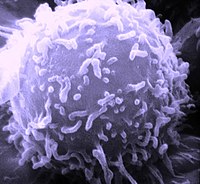
Photo from wikipedia
The presence of a single 8-cell embryo does not alter the transcriptome of the cells of the oviducal isthmus, although a local effect at the precise position of the embryo… Click to show full abstract
The presence of a single 8-cell embryo does not alter the transcriptome of the cells of the oviducal isthmus, although a local effect at the precise position of the embryo cannot be ruled out. Thus, we aimed to study the local embryo effect on the transcriptomic response of the epithelial cells of the oviduct in vivo. Fifteen heifers were synchronized and all showed standing heat and were artificially inseminated. All heifers were slaughtered on Day 2.5 after oestrus. The oviducts from 13 animals (with a corpus luteum, CL) were isolated, trimmed free of tissue and divided between ampulla and isthmus. The ipsilateral isthmus was then divided into smaller sections (2 cm). Each section was sequentially flushed until the embryo was located and was then opened and scraped longitudinally to obtain the epithelial cells. Cells were snap-frozen in LN2 for gene expression analysis. All recovered embryos were found at the beginning of the isthmus of the oviduct ipsilateral to the CL. Three at 2-cell stage and 1 at 8-cell stage. The recovery rate was 30.8% (4/13) and only samples from these 4 animals were used for analysis. The 2-cm sections selected for the transcriptomic analysis were embryo section (ES), in which the embryo was found; proximal section (PS), through which the embryo had passed; distal section (DS), on the uterine side of the embryo; and contralateral section (CS), section from the contralateral isthmus. The expression pattern of 10 differentially expressed genes between the isthmus of pregnant and cyclic heifers (Maillo et al. 2015 Biol Reprod. 92, 144) were assessed by RTq-PCR relative to 2 housekeeping genes, H2A.Z and ACTG. Five up-regulated genes (STK32A, SLC26A3, KERA, QRFPR, MCTP1) and 5 down-regulated (SOD3, PRELP, VAT1L, SOCS3, CCL20) were analysed. One-way ANOVA and t-test was used for statistical analysis. Comparison between ES and the CS revealed one significantly altered gene (VAT1L). This is in agreement with our in vivo results in which VAT1L was also down-regulated in the presence of embryos. Comparison within the ipsilateral oviduct of ES and PS samples revealed STK32A, SLC26A3, QRFPR, MCTP1, and SOCS3 transcripts significantly down-regulated compared with DS samples, whereas the expression for CCL20 was different between ES and DS but similar to the PS. In conclusion, the fact that 5 out of 10 transcripts were different between the segment where the embryo was collected and other locations in the oviduct suggests the presence of embryo site-specific signal. However, comparison between the ipsilateral embryo site with the contralateral site revealed that only one transcript was different. Moreover, the similarities in the ipsilateral oviduct between embryo and proximal site may be due to the passage of the embryo. Furthermore, the location of the embryo close to the ampullary-isthmic junction may mask the effect due to the spatial differences of the bovine oviduct. Research supported by EU, Horizon 2020 Marie Sklodowska-Curie, REPBIOTECH 675526; Spanish MINECO AGL2015-70140-R & AGL2015-66145-R; OECD-CoOperative Prog TAD/CRP JA00092482.
Journal Title: Reproduction, Fertility and Development
Year Published: 2018
Link to full text (if available)
Share on Social Media: Sign Up to like & get
recommendations!